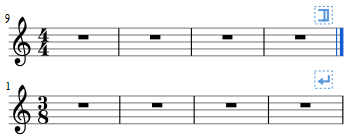Breaks and spacers
The Breaks & Spacers palette contains the following non-printing symbols:

The first three symbols are called breaks; the vertical lines are known as spacers.
Breaks
A break can be applied to either a measure or a frame. There are three types:
- System break: Forces the next part of the score to start in a new system.
- Page break: Forces the next part of the score to start on a new page.
- Section break: Forces the next part of the score to start in a new system and starts a new section (see below). It can be combined with a page break if required.
Notes: (1) Break symbols are visible on the screen, but do not appear on printouts. (2) To add (or remove) system breaks over all or part of the score, see Add/Remove System breaks. (3) To split a measure, see Measure operations: Split and join.
Add a break to a measure
Breaks can be added using either (1) a keyboard shortcut; or (2) a break symbol from a palette.
Using a keyboard shortcut
To add a System break or a Page break only:
- Select any one of the following:
- Barline;
- Measure;
- Notehead;
- Text element associated with a staff (e.g. lyric syllable, chord symbol, staff text etc.);
- Range of measures (if you choose this option, a break will be applied before and after the selection);
- Choose one of the following options:
- System break: Press↵ (toggle).
- Page break: Press Ctrl+↵ (Mac: Cmd+↵) (toggle).
Using a palette break symbol
Any break can be added from a workspace palette:
- Select any one of the following:
- Barline;
- Measure;
- Notehead;
- Text element associated with a staff (e.g. lyric syllable, chord symbol, staff text etc.);
- Range of measures (if you choose this option, a break will be applied before and after the selection);
- Click a break symbol in a palette (double-click in versions prior to 3.4). Repeat to toggle off.
- Alternatively, drag any break symbol from a palette onto a measure.
Add a break to a frame
To add a break to a frame, use one of the following options:
- Drag a break from a palette onto a frame.
- Select a frame then click a palette break symbol (double-click in versions prior to 3.4).
Delete breaks
Use one of the following options:
- Select one or more breaks and press Del.
See also: Add / Remove System breaks.
Move a break
Although breaks are not visible on printed output, you can reposition one, if required, by entering edit mode on it and using the keyboard arrow buttons (see Adjust position of text objects).
Section break
A Section break, as the name suggests, is used to create separate sections within a score. Like a system break, it forces the next measure or frame to begin a new system, and can also be used in association with a page break if required. A section break could be used, for example, to divide a piece into separate movements.
Each section can have its own measure numbering independent of the rest of the score. By default, the first measure of a section is numbered "1" (see image below), though like the first measure of the score itself, the number is not displayed unless configured in the measure properties dialog. The same dialog can be used to change the numbering according to your preference.
If you change Time signature or Key signature at the beginning of the new section, there will be no courtesy signature at the end of the previous section. See example below:

When you play back the score, the program adds a short pause between each section. In addition, the first end repeat barline in a section always sends the playback cursor to the beginning of the section, so a start repeat barline is optional.
The following properties can be adjusted in the Inspector after selecting the section break:
- Pause: Length of pause, in seconds, at end of the section.
- Start new section with long instrument names (checkbox).
- Start new section with measure number one (checkbox).
- Start new section with first system indentation (checkbox, as of 3.6).
Prior to version 3.4, the same properties are accessed by right-clicking the break and selecting Section Break Properties.
Spacers
There are three types of spacers:
- Staff spacer up (Up-pointing arrow): For adding space above a staff. The user sets a minimum height—which may increase (but not decrease) automatically if required by subsequent changes in layout.
- Staff spacer down (Down-pointing arrow): For adding space below a staff. The user sets a minimum height—which may increase (but not decrease) automatically if required by subsequent changes in layout.
- Staff spacer fixed down (Capital letter "I"): For adding a fixed space below the staff. The height set by the user is always adhered to and overrides any automatic layout settings. This spacer can also be used to draw staves closer than autoplacement would normally allow.
Notes: (1) Spacers are designed for local adjustments only. If you wish to adjust the space between staves across the whole score, use the settings in Format → Style... → Page instead. (2) Spacer symbols are visible on the screen, but do not appear on printouts. (3) Spacers cannot be applied to a frame.
Add a spacer
- Either select a measure, then click a palette spacer symbol (double-click in versions prior to 3.4); or, drag a spacer symbol from a palette onto a measure.
- To set the spacer height use one of the following:
- Adjust the "Height" property in the Spacer section of the Inspector.
- Select the spacer and use the ↑↓ keys and/or Ctrl+↑↓ to move the end-handle up and down
- Drag the adjustment handle of the spacer.
Delete a spacer
- Click on the spacer and press the Del key.